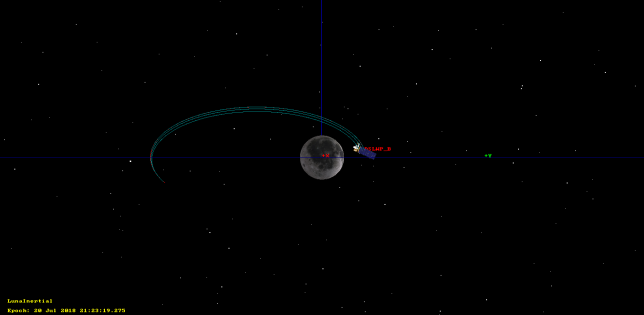On August 15, during a Russian EVA on the ISS, a total of four Russian nanosatellites were deployed by hand. Although different online sources give incomplete and contradictory information about which satellites were released, it seems that they were SiriusSat 1 and 2, from the Sirius educational centre in Sochi, and Tanusha 3 and 4 from the Southwest State University in Kursk (see also Jonathan McDowell’s space report).
The SiriusSats are using 4k8 FSK AX.25 packet radio at 435.570MHz and 435.670MHz respectively, using callsigns RS13S and RS14S. The Tanushas transmit at 437.050MHz. Tanusha-3 normally transmits 1k2 AFSK AX.25 packet radio using the callsign RS8S, but Mike Rupprecht sent me the other day a recording of a transmission from Tanusha-3 that he could not decode.
It turns out that the packet in this recording uses a very peculiar modulation. The modulation is FM, but the data is carried in audio frequency phase modulation with a deviation of approximately 1 radian. The baudrate is 1200baud and the frequency for the phase modulation carrier is 2400Hz. The coding is AX.25 packet radio.
Why this peculiar mode is used in addition to the standard 1k2 packet radio is a mystery. Mike believes that the satellite is somehow faulty, since the pre-recorded audio messages that it transmits are also garbled (see this recording). If this is the case, it would be very interesting to know which particular failure can turn an AFSK transmitter into a phase modulation transmitter.
I have added support to gr-satellites for decoding the Tanusha-3 phase modulation telemetry. To decode the standard 1k2 AFSK telemetry direwolf can be used. The decoder flowgraph can be seen in the figure below.

The FM demodulated signal comes in from the UDP source. It is first converted down to baseband and then a PLL is used to recover the carrier. The Complex to Arg block recovers the phase, yielding an NRZ signal. This signal is lowpass filtered, and then clock recovery, bit slicing and AX.25 deframing is done. Note that it is also possible to decode this kind of signal differentially, without doing carrier recovery, since the NRZI encoding used by AX.25 is differential. However, the carrier recovery works really well, because there is a lot of residual carrier and this is an audio frequency carrier, so it should be very stable in frequency.
The recording that Mike sent me is in tanusha3_pm.wav. It contains a single AX.25 packet that when analyzed in direwolf yields the following.
RS8S>ALL:This is SWSU satellite TANUSHA-3 from Russia, Kursk<0x0d> ------ U frame UI: p/f=0, No layer 3 protocol implemented., length = 68 dest ALL 0 c/r=1 res=3 last=0 source RS8S 0 c/r=0 res=3 last=1 000: 82 98 98 40 40 40 e0 a4 a6 70 a6 40 40 61 03 f0 ...@@@...p.@@a.. 010: 54 68 69 73 20 69 73 20 53 57 53 55 20 73 61 74 This is SWSU sat 020: 65 6c 6c 69 74 65 20 54 41 4e 55 53 48 41 2d 33 ellite TANUSHA-3 030: 20 66 72 6f 6d 20 52 75 73 73 69 61 2c 20 4b 75 from Russia, Ku 040: 72 73 6b 0d rsk. ------
The contents of the packet are a message in ASCII. The message is of the same kind as those transmitted in AFSK.
